Lecture
The problem of learning and development has always been and will be at the center of research not only in educational psychology, but also in many other areas of psychological science (see Fig. 1). Its solution serves as a foundation for didactics and methods of training and education. S.L. Rubinstein wrote that "the right solution to the question of the relationship between development and learning is of central importance not only for psychology, but also for pedagogy. Each concept of education that the teacher formulates includes (he realizes it or not) a certain concept of development. Exactly the same concept of mental development, which the psychologist will formulate (whether he is aware of this or not), also contains a certain theory of learning "(Rubinstein SL, 1946. P. 156).
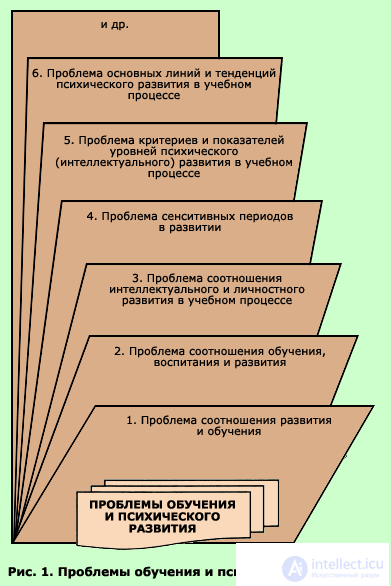
Almost all eminent psychologists of the past and present (Chr. 4.1) were engaged in studying the problem of learning and development in one way or another.
The recognition of the main role of education in the development of natural inclinations was already contained in the works of the founder of pedagogy, Ya.A. Comenius. This idea in one form or another was affirmed by many educators and psychologists over the course of the next centuries, up to the present. In domestic pedagogy, it is reflected in the works of KD. Ushinsky, P.F. Kaptereva, N.Kh. Wessel, K.N. Ventzel, P.P. Blonsky, L.S. Vygotsky et al.
At various historical stages, its decision changed. This is due to the change of methodological attitudes, the emergence of new interpretations in understanding the essence of personal development and the learning process itself, rethinking the role of the latter in this process. The traditional problem of the relationship between learning and development, primarily cognitive, has now been transformed into the problem of the relationship between learning and personal development, setting new perspectives for reforming the education system. The shift in semantic accents in this problem is due to several reasons.
The first is that education in a democratic society cannot be directed only at the formation of knowledge and skills.
The second reason is related to the processes of science development, enrichment and increase in the volume of knowledge, for which educational institutions do not have time, because it is impossible to constantly increase the time of general and professional training. It should be aimed at the formation of self-learning and continuous self-education in students.
The third reason is due to the fact that for a long time taking into account the age characteristics of children was considered a priority and unchanging principle of education. If this were indeed the case, then no training would be able to overcome the limited possibilities of one or another age in nature. Identification of the ratio of training and personal development allows eliminating the seemingly limited age characteristics of students with the help of training, expanding their opportunities
First of all, it should be noted that the problem of the ratio of learning and development is a derivative of a general scientific and general psychological problem, i.e. problems of genotypic and environmental conditions of human development (Khrest. 4.2). As noted by R.S. Nemov, "the problem of genetic sources of psychology and human behavior is one of the most important in the psychological and pedagogical sciences, because the fundamental solution of the question of the possibilities of teaching and educating children, man in general, depends on its correct solution" (Nemov RS, 1995. S. 63; abstract).
In the history of psychological and pedagogical thought, one can distinguish three points of view on the question of the relationship between the influence of genotypic and environmental factors on human development. We take the point of view of A.G. Asmolov (Asmolov AG, 1996).
As the scientist emphasizes, both concrete actions in relation to the individual and theoretical schemes for the analysis of personality development depend on the images of a person in culture and science. The predominance in the psychology of the personality of the images of a "feeling person", "needy person" and "programmed person" largely determined the real fact of the mismatch of the concepts of the individual, personality and individuality and the separate formation of biogenetic , sociogenetic and personogenetic orientation of human knowledge.
Representatives of the biogenetic orientation focus on the problems of human development as an individual with certain anthropogenetic properties (inclinations, temperament, biological age, gender, body type, neurodynamic properties of the brain, organic impulses, etc.) that pass through various stages of maturation as phylogenetic programs of the species in ontogenesis. The basis of individual maturation is mainly the adaptive processes of the body, which are studied in such scientific areas as psychophysiology of individual differences, psychogenetics, psychosomatics, neuropsychology, psycho-endocrinology and sexology
Representatives of different sociogenetic orientations mainly study the processes of human socialization, their mastering of social norms and roles, acquiring social attitudes and value orientations, the formation of a person’s social and national character as a typical member of a particular community. The problems of socialization, or - in a broad sense - social adaptation of a person, are developed mainly in social psychology, ethnopsychology, historical psychology.
The focus of the personal genetic orientation is the problem of activity, self-awareness and creativity of the individual, the formation of the human I, the struggle of motives, the education of an individual character and abilities, the self-realization of personal choice, the incessant search for the meaning of life in the course of the life path of individuality. The general psychology of the personality is connected with the study of all these manifestations of personality, different aspects of which are covered in psychoanalysis, individual psychology, analytical psychology and humanistic psychology.
In the isolation of the biogenetic, sociogenetic, and personogenetic directions, a metaphysical scheme of determination of the development of the individual under the influence of two factors — the environment and heredity — manifests itself. Within the framework of the system-based historical evolutionary approach developed by A.G. Asmolov, developed a fundamentally different scheme for the determination of personality development. In this scheme, the properties of a person as an individual are considered as “impersonal” prerequisites for the development of personality, which in the process of life’s path can become the product of this development.
 By the beginning of the 30s. Twentieth century. more or less clearly revealed the three main theories about the ratio of learning and development. They were described by L.S. Vygotsky (Vygotsky LS, 1996, abstract) (see Fig. 2)
By the beginning of the 30s. Twentieth century. more or less clearly revealed the three main theories about the ratio of learning and development. They were described by L.S. Vygotsky (Vygotsky LS, 1996, abstract) (see Fig. 2)
According to the first point of view expressed by the well-known Swiss psychologist J. Piaget and developed by his school, the connection between learning and child development is denied. This independence is expressed, in particular, in the fact that the child’s thinking passes through certain stages, regardless of whether he is studying or not. And the relativity of the independence of these processes is that in order for learning to become possible, development must prepare an appropriate basis for this. Training in this case "is in the tail of development", it seems to be built on maturation
Thus, the first theory has as its main position the idea of the independence of child development from learning processes. According to this theory, “development must complete certain completed cycles, certain functions must mature before the school can begin to learn certain knowledge and skills of the child. The development cycles always precede the learning cycles. Learning lags behind the development, development always goes ahead of learning. Thanks to this, any opportunity to raise the question of the role of learning itself in the course of development and maturation of those functions that are activated by instruction is eliminated in advance. its prerequisite than the result of training. Training is built on development, without changing anything in it essentially ”(LS Vygotsky, 1991, p. 376).
According to this theory, the development of a child is a consequence of internal, spontaneous self-change, on which learning has no effect. According to J. Piaget, the child’s thinking necessarily goes through all known phases and stages, regardless of the learning process. Moreover, training is determined by the level of human development. "Development creates opportunities - learning them implements," - wrote V. Stern. Education is only the external conditions of maturation, child development. It is considered as "a purely external process that must somehow be coordinated with the course of child development, but by itself not participating actively in child development, which does not change anything in it and rather uses development achievements than motivates the course and changes its direction" (Ibid. P. 375). Naturally, this point of view does not recognize the very idea of developmental education. This point of view was held by A. Gesell, 3. Freud and others
Some of the modern domestic and foreign children's psychologists and educators hold to the positions of this theory, which LS Sokolov clearly and unambiguously described. Vygotsky. Many believe that the pedagogical life itself, the long-standing established practice of education, stand behind such positions, because this psychological theory corresponds to the famous didactic principle - the principle of accessibility (according to him, as you know, the child can and should be taught only what he can understand for which he has already matured certain cognitive abilities). The first theory, of course, does not recognize developmental education — this is the theoretical rationale for the practice of education, in principle, it excludes any possibility of manifestation of such training
According to the second point of view , learning and development are identical (W. James, E. Thorndike, and others). It is believed that the child develops to the extent that he learns, therefore development is learning, and learning is development. Each step of learning was also considered a step of student development. At the same time, E. Thorndike did not see the difference between human learning and animal learning, he denied the role of consciousness in learning.
Thus, the second theory, according to LS. Vygotsky adheres to the point of view that learning is development, that the former fully merges with child development, when every step in learning corresponds to a step in development (in this development is reduced mainly to the accumulation of all kinds of habits). A supporter of this theory was, for example, such a major American psychologist, as V. James.
These views were shared by W. James, J. Watson, K. Koffka, although they understood the nature of the training differently. They believed that any learning is developing, since, for example, teaching children any grammatical knowledge already leads to the development of valuable mental activities (habits) in them. This point of view is very convenient for practitioners, since it justifies any actions of teachers (teachers, methodologists, etc.).
Naturally, according to this theory, any learning is developing, since teaching children, for example, to some kind of mathematical knowledge, can lead to the development of valuable intellectual habits. It should be borne in mind that teachers and methodologists who rely in their work primarily on practical experience may be advocates of just such a theory that does not require quite complex procedures for distinguishing between the processes of “learning” and the processes of “development” (and sometimes they are distinguishable)
The third theory attempts to combine the first two (K. Koffka). She sees development itself as a dual process: as maturation and as learning. And from this it follows that maturation somehow affects learning, and learning, in turn, affects maturation. In this case, learning is understood as the process of the emergence of new structures and the improvement of old ones, and therefore learning can proceed not only after development, but also ahead of it, causing new growth in it.
In this theory, attempts have been made to overcome the extremes of the first two by simply combining them. On the one hand, development is thought of as a process, independent of learning. On the other hand, learning itself, in which the child acquires new forms of behavior, is considered to be identical to development. According to the third theory, development (maturation) prepares and makes learning possible, and the latter stimulates and pushes development (maturation) forward.
At the same time, according to this theory, as LS wrote. Vygotsky, "development is always a wider circle than learning ... The child learned to perform any operation. Thus, he learned a structural principle, the scope of which is wider than just the type of operation on which this principle was learned Consequently, making a step in learning, the child moves two steps in development, that is, learning and development do not coincide "(Vygotsky, LS, 1991. p. 381-382). This theory divides the processes of learning and development and at the same time establishes their interconnection (development prepares learning, and learning stimulates development).
L.S. Vygotsky identified two main features in this theory. The first is the recognition of the relationship between learning and development, the disclosure of which allows you to find the stimulating effect of learning and how a certain level of development contributes to the realization of a particular learning. This aspect was actively developed by G.S. Kostiuk (Kostiuk G.S., 1988), N.A. Menchinskaya (Menchinskaya N.A., 1998) and others.
The second feature is characterized by attempts to explain the presence of developmental education, based on the attitudes of structural psychology, which was represented by K. Koffka. The essence of such an explanation consists in the assumption that the child, mastering any particular operation, at the same time masters some general structural principle, the scope of which is much broader than that of this operation. By mastering it, he later gets the opportunity to use this principle when performing other operations. L.S. Выготский пишет о том, что, согласно взглядам К. Коффки, образование структуры в одной какой-либо области неизбежно приводит к облегчению развития структурных функций и в других областях и подчеркивает, что "если отталкиваться от рассмотренных теорий, то можно наметить более правильное решение вопроса об отношении обучения и развития" (Выготский Л.С., 1991). Это свидетельствует о том, что сам он в решении данного вопроса не соглашался ни с одной из этих теорий, даже с третьей, которой по-видимому, симпатизировал в наибольшей степени. В сжатом виде ученый формулирует свою позицию так: "Самым существенным для выдвигаемой здесь гипотезы является положение о том, что процессы развития не совпадают с процессами обучения, что первые идут вслед за вторыми, создающими зоны ближайшего развития. Наша гипотеза устанавливает единство, но не тождество процессов обучения и внутренних процессов развития. Она предполагает переход из одного в другое" (Там же. С. 389). И далее: "Вторым существенным моментом гипотезы является представление о том, что хотя обучение и связано непосредственно с детским развитием, тем не менее они никогда не идут равномерно и параллельно друг другу... Между процессами развития и обучением устанавливаются сложнейшие динамические зависимости, которые нельзя охватить единой, наперед данной, априорной умозрительной формулой" (Там же. С. 390).
These theories about the ratio of learning and development described by L.S. Vygotsky more than seventy is not back, in some modifications exist in modern psychology, having the corresponding factual basis of both experimental and practical nature. Each of them (especially the first and third) has its supporters, but according to its internal meaning, these theories divide them into two camps. The first is those who do not recognize the influence of learning on the development of children and denies the very possibility of developmental learning (supporters of the first theory). The second camp unites those who recognize the presence of developmental education regardless of how it can be interpreted (these are supporters of the second and, mainly, the third theory).
Интенсивные исследования отечественных психологов в 40-60-е гг. XX century. способствовали дальнейшей разработке проблемы соотношения обучения и развития прежде всего по линии выявления условий, при которых обучение становится развивающим, определения конкретных форм обучения, обеспечивающего более высокое умственное развитие детей различного школьного возраста в условиях как индивидуальных, так и групповых экспериментов (с целыми классами) (см. рис. 3).
Wherein:
В ряде исследований было установлено:
В работах Г.С. Костюка и его сотрудников специально рассматривались различные формы взаимозависимости обучения и развития (Костюк Г.С., 1988). В трудах П.П. Блонского показан сложный механизм взаимоотношений между знанием и мышлением: с одной стороны, овладение знаниями является необходимым условием развития мышления, а с другой - вне мыслительного процесса не может быть усвоения знаний (Блонский П.П., 1999)
В основу разрабатываемой в отечественной возрастной и педагогической психологии концепции о соотношении обучения и умственного развития ребенка легло положение о зонах актуального развития (ЗАР) и зоне ближайшего развития (ЗБР). Эти уровни психического развития были выделены Л.С. Выготским (см. рис. 4).
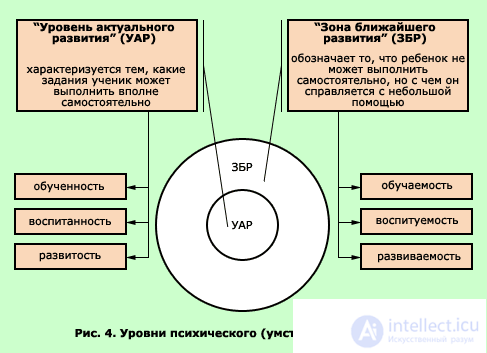
L.S. Выготский показал, что реальное соотношение умственного развития к возможностям обучения может быть выявлено с помощью определения уровня актуального развития ребенка и его зоны ближайшего развития. Обучение, создавая последнюю, ведет за собой развитие; и только то обучение действенно, которое идет впереди развития.
Зона ближайшего развития - это расхождения между уровнем актуального развития (он определяется степенью трудности задач, решаемых ребёнком самостоятельно) и уровнем потенциального развития (которого ребёнок может достигнуть, решая задачи под руководством взрослого и в сотрудничестве со сверстниками) .
Ученый считал, что ЗБР определяет психические функции, находящиеся в процессе созревания. Она связана с такими фундаментальными проблемами детской и педагогической психологии, как возникновение и развитие высших психических функций, соотношение обучения и умственного развития, движущие силы и механизмы психического развития ребёнка. Зона ближайшего развития - следствие становления высших психических функций, которые формируются сначала в совместной деятельности, в сотрудничестве с другими людьми, и постепенно становятся внутренними психическими процессами субъекта.
Зона ближайшего развития свидетельствует о ведущей роли обучения в умственном развитии детей. "Обучение только тогда хорошо, - писал Л.С. Выготский, - когда оно идёт впереди развития". Тогда оно пробуждает и вызывает к жизни много других функций, лежащих в зоне ближайшего развития. Обучение может ориентироваться на уже пройденные циклы развития - это низший порог обучения, но оно может ориентироваться на ещё не созревшие функции, на ЗБР, - это высший порог обучения; между этими порогами и находится оптимальный период обучения. ЗБР даёт представление о внутреннем состоянии, потенциальных возможностях развития ребенка и на этой основе позволяет дать обоснованный прогноз и практические рекомендации об оптимальных сроках обучения как для массы детей, так и для каждого отдельного ребёнка. Определение актуального и потенциального уровней развития, а также ЗБР составляет то, что Л.С. Выготский называл нормативной возрастной диагностикой, в отличие от симптоматической диагностики, опирающейся лишь на внешние признаки развития. В этом аспекте зона ближайшего развития может быть использована как показатель индивидуальных различий детей. В отечественной и зарубежной психологии проводятся исследования с целью разработки методик, позволяющих качественно описать и количественно оценить ЗБР.
ЗБР может быть выявлена и при изучении личности ребёнка, а не только его познавательных процессов. При этом выясняется разница между стихийно складывающимися в процессе социализации личностными характеристиками и теми сдвигами в развитии личности, которые происходят в результате направленных воспитательных воздействий. Оптимальные условия для выявления ЗБР личности создаёт интеграция её в коллективе
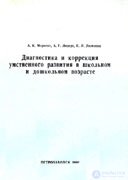 A.K. Маркова выделила основные "пласты" развития и их показатели в соответствии с уровнями психического развития (Маркова А.К., 1992; аннотация). Среди основных "пластов" уровня актуального развития она выделила обученность, развитость и воспитанность, а в зоне ближайшего развития - обучаемость, развиваемость, воспитуемость (см. рис. 5).
A.K. Маркова выделила основные "пласты" развития и их показатели в соответствии с уровнями психического развития (Маркова А.К., 1992; аннотация). Среди основных "пластов" уровня актуального развития она выделила обученность, развитость и воспитанность, а в зоне ближайшего развития - обучаемость, развиваемость, воспитуемость (см. рис. 5).
Обученность. Прежде всего надо выявить наличный уровень того, что уже сложилось в опыте ребенка, что явилось результатом всего предшествующего обучения (систематического и стихийного, воздействий на ребенка учителей, родителей, сверстников) и на что можно опереться в дальнейшей работе. Каждый учащийся владеет определенным запасом знаний и тем или иным уровнем умения учиться. Это принято называть обученностью. Ведь учение направлено на переход ученика из состояния необученности в состояние обученности. Обученность - это, с одной стороны, результат прошлого опыта, а с другой - цель предстоящего обучения . Степень обученности зависит от степени реализации цели обучения. Поэтому задача обучения - создать условия реализации обучаемости и перехода ребенка к новому уровню обученности.

Знания очень неоднородны, они имеют разную психологическую значимость. Можно различить виды знаний, этапы и уровни их усвоения. Виды знаний: знания о фактах, понятия и термины, законы и теории, знания о способах деятельности и методах познания. Очевидно, что более весомыми для умственного развития являются законы и теории, знания о деятельности, хотя знания о фактах подготавливают сдвиги в развитии
Развитость. Каждый учащийся к сегодняшнему моменту имеет тот или иной уровень развития (развитость) . Это актуальный уровень развития, не совпадающий с обученностью. B.G. Ананьев писал: "В процессе определенного вида деятельности создаются не только определенный аппарат действий, знаний и навыков, но и потенциал развития человека. Эта характеристика человеческого развития в виде обучаемости, воспитуемости, способностей к развитию имеет для педагогики не меньшее значение, чем обученность, воспитанность, образованность человека в определенный момент воспитания" (Ананьев Б.Г., 1980. Т. 2. С. 18). У обучающегося может быть высокий уровень развития (у него хорошие способности), но низкая обученность; и, напротив, у ребенка может быть низкий уровень развития, не очень хорошие способности, но он натренирован, обучен. Развитость - это совокупность характеристик развития. Развитость - это действование в уме, действование с абстрактными отношениями, познавательная инициатива и т. д
Далее переходим к диагностике собственно умственного развития. Ни знания, ни учебная деятельность не являются самоцелью обучения. Конечной целью является вклад в умственное развитие, качественные позитивные сдвиги в нем. Поэтому определение развитости у школьника включает:
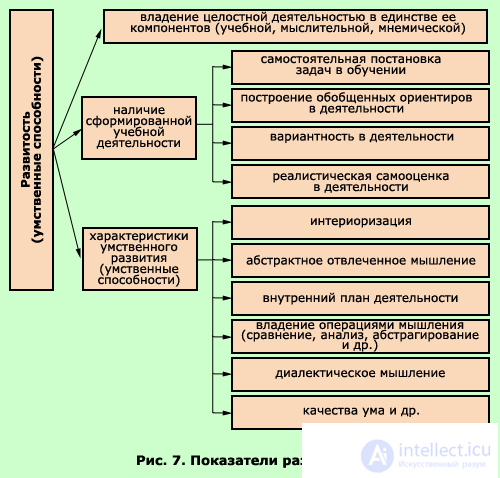
The identification of these parameters brings us closer to penetration into the essence of mental development. The ratio of the various indicators of mental development needs further study.
Nurture At each given moment, the student is at a certain level of personal development (unconditionally related to mental development). It is called education .
An important step in determining the development of schoolchildren is the identification of the student’s personal characteristics in the learning process. Mental development can not be separated from the personal, from the education of the student. Being educated cannot be reduced to external rules of etiquette of behavior (he missed the elder at the door, first greeted the elder). Being brought up is not a sum, a conglomerate of many qualities of a student (from sincerity to internationalism).

At the same time, a certain zone of its potential possibilities, prospects, and zone of proximal development correspond to each stage of the child’s life (LS Vygotsky). B.G. Ananyev, noting that primary school education may not lead to development, wrote: "The progress of children's learning does not directly entail an increase in learnability" (Ananyev, BG, 1962, p. 24).
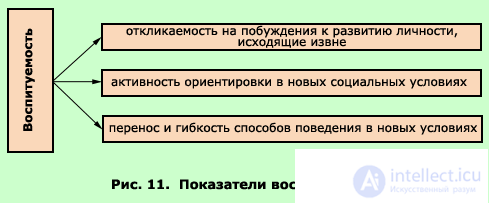
Properly organized learning relies on the child's BSS, not mental processes that begin to take shape in his work with adults, and then function in his activities. ZBR helps to characterize opportunities and prospects for development. Its definition is important for the diagnosis of mental development
In the field of education there is one or another susceptibility, sensitivity to the assimilation of knowledge, the ability to further learning, susceptibility to learning influences from the outside. This phenomenon is called learning . Fairly celebrated T.I. Goncharova, that "a schoolchild remains only a learner and education, he is an object, not the subject of the process of knowledge of the world, his passive position is the main evil of the organization of the educational process" (Goncharova T.I., 1987. P. 27).
Learning in the broad sense of the word - the ability to learn knowledge and methods of action, the willingness to move to new levels of learning . In this case, it acts as a manifestation of the general abilities of the student, reflecting the cognitive activity of the subject and his ability to learn new knowledge, actions, complex forms of activity. Expressing general abilities, learnability acts as a general possibility of mental development, the attainment of more generalized systems of knowledge, general modes of action. Learning is characterized by individual indicators of the speed and quality of a person’s mastering the knowledge and skills in the learning process (see Fig. 12).
There are different shades in the understanding of learning. “Children with the same level of mental development under the guidance of a teacher are capable of learning in completely different sizes <...> one child of 8 years old is able to solve a problem for a 12-year-old and another - a 9-year-old” (LS Vygotsky, 1991. p. 399). Learning is not the same as learning. The ability to learn does not coincide with the development of the child, respectively, in the diagnosis should be highlighted separately. N.S. Leites, confirming the position of the discrepancy between development (development) and learning, quotes Aristotle: "Why, when we are older, our mind is stronger, and when younger, we learn more easily" (Leites NS, 1971).
“Although learning is directly related to child development, they never go evenly and parallel to each other. Child development should never be a shadow behind the object that throws it away, school education. Therefore, school achievement tests never reflect the real course of child development "(Vygotsky, LS, 1991. C. 390).
As an empirical characteristic of a student’s learning abilities, learning includes many indicators and parameters of the student’s personality.
An important characteristic of learning are the qualities that determine the possibilities of communication, and the corresponding manifestations of personality.
Learning is formed from early childhood. Of particular importance is the formation of opportunities for learning on sensitive periods of human learning - in the transition from preschool childhood to systematic schooling, from school to special education, involving the mastery of various types of professional activity.
Thus, the notion of learning, along with general characteristics (higher cognitive abilities and abilities for self-control in the process of fulfilling learning tasks), includes some significant features that contribute to learning at various age levels of a person’s mental development. For a preschooler, such special qualities are those that provide him with great opportunities to participate in gaming activities; for the student - the possibility of more accurate implementation of various school requirements; for the student - the possibility of mastering the professional activity and independence of learning.
In psychology, different types of learning are considered (see Fig. 13). Usually they differ: a) general learning ability - the ability to assimilate any material; b) special learnability is the ability to master certain types of material: various fields of science, art, and areas of practical activity. The first is an indicator of general, the second is a special endowment of the individual.
Learning is determined not only by the level of development of cognition active (in that the subject can learn and learn independently), but also in the level of cognition of the "receptive" (in that the subject can learn and learn with the help of another person who has knowledge and skills). Therefore, learning as an ability to learn and assimilate differs from the ability to self-knowledge and cannot be fully evaluated only by its development indicators. The maximum level of development of learning is determined by the possibilities of independent cognition.
Learning is mental development over time, so its presence is a reliable indicator of the progressive nature of development. Such manifestations of the dynamics of mental development, such as developability, reducibility - have similar signs, for example, responsiveness to external influences, switchability (from one thinking plan to another, from one way of social behavior to another). Learning, developing, and educating are best revealed in an individual learning and formative experiment, in constant comparison with vital signs during a longitudinal study. "To take into account the dynamics of individual reforming means to penetrate into the innermost meaning of her being, and this is the main psychological core of upbringing."
Learning is broadly understood as adaptability. The idea is expressed that learning in a biological sense is an aspect of biological defense: changing the environment to certain limits, not exceeding the system's functioning, causes a protective type of reaction, through which the ability to learn is manifested and established. Learning in humans is no longer a single act of biological defense, but includes the social experience of previous generations.
B.V. Zeygarnik in the preface to the book A.Ya. Ivanova notes that learning is a range of potential opportunities for children to master new knowledge in work friendly with adults. B.G. Ananiev understands learnability as the preparedness of the human psyche throughout the previous segment of its formation to its rapid development in the learning process in a strictly defined direction (Ananiev BG, 1962. P. 23). 3.I. Kalmykova treats learning as one of the main indicators of mental development, understands it as a system of intellectual qualities of the mind, on which the productivity of learning activities depends on other things being equal (minimum knowledge, motivation) (Kalmykova ZI, 1979, p. 7). Learning is "a system, an ensemble of intellectual personality traits, the evolving qualities of its mind, on which the productivity of learning activities depends - in the presence of an initial minimum of knowledge, attitudes to learning, and other necessary conditions." The individual combination of mental qualities determines individual differences in learning.
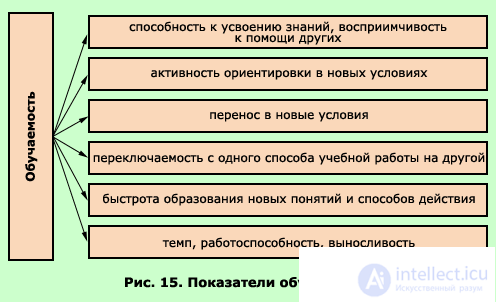
*******
So, the problem of learning and development has been and remains one of the core problems of educational psychology. Its solution serves as a foundation for didactics and methods of training and education. At different historical stages, its decision changed, which was due to a change in methodological guidelines, the emergence of new interpretations of understanding the essence of personal development and the learning process itself, and a rethinking of the role of the latter in this development. L.S. Vygotsky identified three main theories about the relationship between learning and development.
The solution of this problem is closely connected with the concept of the zone of proximal development (BSR), the author of which is L.S. Vygotsky. The zone of proximal development characterizes the degree of discrepancy between the level of actual development (CAR) and the level of potential. The main "layers" of UAR, according to A.K. Markova, are training, education, development, and the ZBR - learning, developability and reducibility.
Currently, the problem of the ratio of learning and mental development has been transformed into the problem of the ratio of learning and personal development, defining new perspectives of reforming the education system.
продолжение следует...
Часть 1 4. TRAINING AND DEVELOPMENT
Часть 2 Topics of coursework and essays - 4. TRAINING AND DEVELOPMENT
Comments
To leave a comment
Pedagogical psychology
Terms: Pedagogical psychology